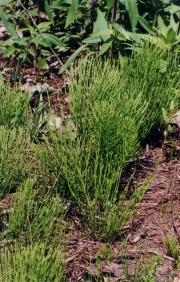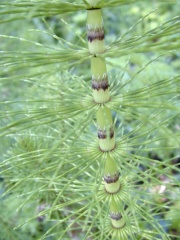Difference between revisions of "Horsetail"
m (Text replace - "== Authority ==" to "== Sources Checked for Data in Record ==") |
|||
| (2 intermediate revisions by the same user not shown) | |||
| Line 4: | Line 4: | ||
A nonflowering, grass-like plant of the genus ''Equisetum'', such as ''Equisetum hyemale'', found in wet, swampy soil. In medieval times, horsetail was imported from Holland. It was called Dutch rush and used for cleaning pots and burnishing [[metal]]. Horsetail stems contain fine-grain [[silica]] with small angular fingers. They are used as an [[abrasive]] for polishing [[veneer]], burnishing [[clay]], and smoothing [[gesso]] grounds. | A nonflowering, grass-like plant of the genus ''Equisetum'', such as ''Equisetum hyemale'', found in wet, swampy soil. In medieval times, horsetail was imported from Holland. It was called Dutch rush and used for cleaning pots and burnishing [[metal]]. Horsetail stems contain fine-grain [[silica]] with small angular fingers. They are used as an [[abrasive]] for polishing [[veneer]], burnishing [[clay]], and smoothing [[gesso]] grounds. | ||
| − | [[File:Equisetumstemvt.jpg|thumb|Horsetail | + | [[File:Equisetumstemvt.jpg|thumb|Horsetail ''Equisetum telmateia'']] |
| − | |||
| − | ''Equisetum telmateia'']] | ||
== Synonyms and Related Terms == | == Synonyms and Related Terms == | ||
| Line 12: | Line 10: | ||
Equisetum hyemale (scouring rush); Dutch rush; rough horsetail; shave grass; scrub grass; gun bright; snake rush; polishing rush; winter rush; evergreen rush; candock; padderok (Dan.; Schachtelhalme (Deut.); prêle (Fr.); sphénophyte (Fr.); asprele (Old French); paardenstaart (Ned.); sneller (Nor.); skrzyp (Pol.) | Equisetum hyemale (scouring rush); Dutch rush; rough horsetail; shave grass; scrub grass; gun bright; snake rush; polishing rush; winter rush; evergreen rush; candock; padderok (Dan.; Schachtelhalme (Deut.); prêle (Fr.); sphénophyte (Fr.); asprele (Old French); paardenstaart (Ned.); sneller (Nor.); skrzyp (Pol.) | ||
| − | == | + | == Physical and Chemical Properties == |
| − | |||
| − | |||
| − | |||
| − | |||
| − | + | * Height = 0.2 - 1.5 M | |
| + | * Stems=hollow and jointed with vertical ridges | ||
| + | * Leaves = small and pointed growing in a whorl from each node | ||
[[File:horsetailstrobiluslarge.jpg|thumb|Horsetail]] | [[File:horsetailstrobiluslarge.jpg|thumb|Horsetail]] | ||
| Line 25: | Line 21: | ||
[[media:download_file_205.pdf|Properties of Common Abrasives]] | [[media:download_file_205.pdf|Properties of Common Abrasives]] | ||
| + | ==Resources and Citations== | ||
| − | + | * C.Powell, "The Use of ''Equisetum hyemale'' (PrÛle/Horsetail/Dutch rush) as an Abrasive in the Gilding Process on Wood" ''Conservation News'' 66:p.40, 1998. | |
| − | |||
* Hermann Kuhn, ''Conservation and Restoration of Works of Art and Antiquities'', Butterworths, London, 1986 | * Hermann Kuhn, ''Conservation and Restoration of Works of Art and Antiquities'', Butterworths, London, 1986 | ||
| Line 33: | Line 29: | ||
* ''The American Heritage Dictionary'' or ''Encarta'', via Microsoft Bookshelf 98, Microsoft Corp., 1998 | * ''The American Heritage Dictionary'' or ''Encarta'', via Microsoft Bookshelf 98, Microsoft Corp., 1998 | ||
| − | * Wikipedia | + | * Wikipedia: http://en.wikipedia.org/wiki/Horsetail (Accessed Oct. 30, 2004) |
[[Category:Materials database]] | [[Category:Materials database]] | ||
Latest revision as of 16:51, 9 September 2022
Description
A nonflowering, grass-like plant of the genus Equisetum, such as Equisetum hyemale, found in wet, swampy soil. In medieval times, horsetail was imported from Holland. It was called Dutch rush and used for cleaning pots and burnishing Metal. Horsetail stems contain fine-grain Silica with small angular fingers. They are used as an Abrasive for polishing Veneer, burnishing Clay, and smoothing Gesso grounds.
Synonyms and Related Terms
Equisetum hyemale (scouring rush); Dutch rush; rough horsetail; shave grass; scrub grass; gun bright; snake rush; polishing rush; winter rush; evergreen rush; candock; padderok (Dan.; Schachtelhalme (Deut.); prêle (Fr.); sphénophyte (Fr.); asprele (Old French); paardenstaart (Ned.); sneller (Nor.); skrzyp (Pol.)
Physical and Chemical Properties
- Height = 0.2 - 1.5 M
- Stems=hollow and jointed with vertical ridges
- Leaves = small and pointed growing in a whorl from each node
Comparisons
Properties of Common Abrasives
Resources and Citations
- C.Powell, "The Use of Equisetum hyemale (PrÛle/Horsetail/Dutch rush) as an Abrasive in the Gilding Process on Wood" Conservation News 66:p.40, 1998.
- Hermann Kuhn, Conservation and Restoration of Works of Art and Antiquities, Butterworths, London, 1986
- The American Heritage Dictionary or Encarta, via Microsoft Bookshelf 98, Microsoft Corp., 1998
- Wikipedia: http://en.wikipedia.org/wiki/Horsetail (Accessed Oct. 30, 2004)


